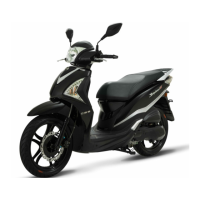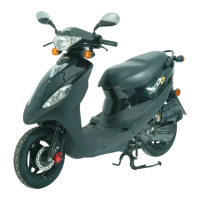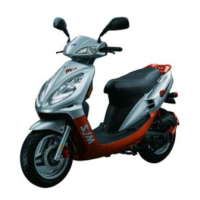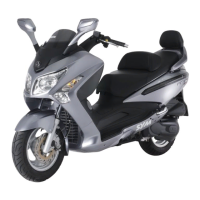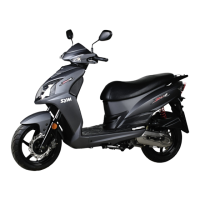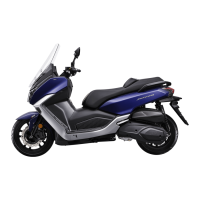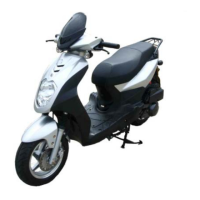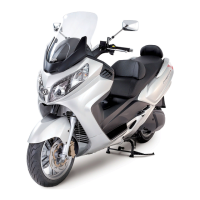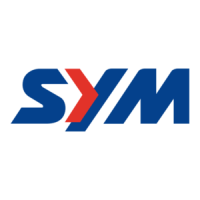
Do you have a question about the Sym X'PRO RV125 and is the answer not in the manual?
Discusses precautions for safe operation, including hazards of exhaust, fuel, and hot components.
Details technical specifications for the motorcycle model, covering dimensions, performance, and engine.
Lists essential torque specifications for various bolts and nuts during assembly and maintenance.
Provides guidelines for correctly routing wires and cables to prevent damage and ensure safety.
Offers a diagnostic guide for common engine starting and running issues in carburetor models.
Provides a diagnostic guide for common engine starting and running issues in EFI models.
Illustrates key locations requiring lubrication for proper motorcycle operation and maintenance.
Outlines essential safety and operational warnings before performing maintenance tasks on the motorcycle.
Details a recommended schedule for regular inspection, cleaning, and replacement of motorcycle parts.
Covers the inspection and maintenance procedures for the motorcycle's fuel delivery system.
Describes the procedure for removing and inspecting the air cleaner element for optimal engine performance.
Details the process for removing, inspecting, and replacing the spark plug, including gap measurement.
Explains the steps for checking and adjusting valve clearance to ensure correct engine timing and performance.
Covers the procedure for checking the transistor ignition system's functionality and timing.
Explains the maintenance and inspection of the front and rear hydraulic disc brake systems.
Explains the step-by-step process for bleeding air from the hydraulic brake system to ensure proper lever feel.
Covers the inspection of tire pressure, surface condition, and thread depth for safe operation.
Outlines general information and precautions for engine oil pump and gear oil replacement procedures.
Provides a guide for diagnosing and resolving issues related to low engine oil level, dirty oil, or low oil pressure.
Details the procedure for checking, draining, and refilling engine oil, including capacity and torque values.
Explains how to measure clearances within the oil pump to ensure it is within service limits.
Covers the inspection and change procedure for the gear oil, including quantity and torque values.
Highlights safety warnings related to gasoline and precautions for disassembling fuel system components.
Provides a comprehensive list of common engine starting and running problems with their potential causes.
Explains the inspection procedure for the air cut-off valve, including specified vacuum and air pressure values.
Details the inspection, removal, and installation process for the auto by-starter system.
Guides through the steps required to safely remove the carburetor assembly from the motorcycle.
Explains the disassembly, checking, and cleaning procedures for the carburetor's float chamber.
Describes the procedure for adjusting the pilot screw for optimal idle speed and CO emissions.
Covers the removal and installation procedures for the fuel tank and its associated components.
Introduces the EFI system, its components, and its advantages over traditional carburetor systems.
Illustrates the key components of the EFI system, including sensors, ECU, injectors, and fuel pump.
Shows the physical locations of the various EFI system components on the motorcycle for easy identification.
Provides detailed descriptions of the function and characteristics of major EFI system components like ECU and sensors.
Presents the electrical schematic diagram of the EFI system, detailing wiring and connections between components.
Highlights safety precautions and procedures related to handling fuel pressure and disassembling EFI system parts.
Offers a systematic approach to diagnosing EFI system faults using diagnostic codes and circuit inspection.
Details the recommended cleaning procedure for the throttle body and air by-pass valve for optimal engine performance.
Describes the principle of operation, specifications, and components of the computerized ignition control system.
Explains the function and operation of the crankshaft position sensor in determining engine speed and timing.
Explains how to interpret check lamp signals (Service Priority and Flash Codes) for diagnosing EFI system faults.
Outlines general information and precautions for engine removal, emphasizing the need for special tools and frame support.
Provides a step-by-step guide for removing the engine from the motorcycle when equipped with a carburetor system.
Details the procedure for removing the engine from the motorcycle when equipped with an Electronic Fuel Injection (EFI) system.
Covers the removal and installation of the engine hanger, including inspection of its rubber bush for damage.
Guides through the process of reinstalling the engine, emphasizing safety, wire routing, and torque values.
Illustrates the components of the cylinder head and valve train assembly, including torque specifications for key parts.
Details general information and specifications related to cylinder head, valve, and camshaft service.
Provides a step-by-step guide for removing the cylinder head assembly from the engine.
Explains the process of disassembling the cylinder head, including valve removal and spring compression.
Guides through the procedure for replacing valve stems, including heating the cylinder head and using specific tools.
Describes methods for inspecting valve seats, including checking width, contact condition, and grinding procedures.
Details the steps for reassembling the cylinder head, including valve stem oil seal installation and spring compression.
Guides through the process of installing the cylinder head back onto the engine, including torque values and gasket placement.
Illustrates the components of the cylinder and piston assembly, showing their interrelationships.
Provides general information and specifications for cylinder and piston service, applicable when the engine is mounted.
Lists common issues related to cylinder and piston performance, such as low compression, noise, smoking, and overheating.
Details the step-by-step procedure for removing the cylinder from the engine block.
Explains how to safely remove the piston from the cylinder, including precautions for handling piston rings.
Guides through the proper installation of piston rings into their grooves on the piston, emphasizing correct orientation.
Describes the procedure for installing the piston into the cylinder, including lubrication and alignment marks.
Shows an exploded view of the V-belt drive system components, including torque specifications for assembly.
Outlines general precautions and service data for the V-belt drive system, emphasizing grease-free components.
Lists common issues and their probable causes related to the V-belt drive system, such as inability to move or poor performance.
Explains the removal, inspection, and installation of the drive belt, including service limits for belt width.
Covers the removal and inspection procedures for the drive face components, including measuring diameters and checking for wear.
Details the disassembly and inspection of the clutch outer and driven pulley, including measurements and component checks.
Illustrates the components of the final drive mechanism, showing their arrangement and torque values.
Provides specifications for application oil, torque values, tools, and troubleshooting tips for the final drive system.
Lists common problems related to the final drive, such as engine not moving, noise, and gear oil leaks, with their causes.
Guides through the steps for disassembling the final drive mechanism, including draining gear oil and removing covers.
Details the procedure for inspecting and replacing bearings in the final drive mechanism, emphasizing the use of specific tools.
Guides through the reassembly process of the final drive mechanism, including bearing installation and lubrication.
Shows an exploded view of the AC generator and start clutch components with torque specifications for assembly.
Provides general information, specifications, torque values, and special tools required for AC generator and start clutch service.
Covers the removal, inspection, and disassembly of the start clutch assembly and its related gears.
Details the procedure for installing the flywheel onto the crankshaft, including pin alignment and nut tightening.
Explains how to install the AC generator assembly onto the right crankcase cover, ensuring secure wire harness placement.
Illustrates the crankshaft and crankcase components, showing their arrangement and torque values.
Provides operational precautions and service data for crankshaft and crankcase disassembly and assembly.
Lists common engine noises and their potential causes related to crankshaft and crankcase components.
Details the step-by-step procedure for disassembling the crankcase, including cam chain and tensioner removal.
Explains how to inspect the crankshaft for run-out, bearing condition, and connecting rod clearances.
Guides through the process of assembling the crankcase, including bearing installation and crankshaft placement.
Shows a diagram of the cooling system components, including the radiator, water pump, and thermostat.
Provides technical specifications, torque values, tools, and safety warnings for the cooling system.
Lists common problems related to engine temperature (too high or too low) and coolant leaks, with their causes.
Explains how to test the cooling system's filler cap and check for overall system leakage.
Details the procedure for safely draining, refilling, and bleeding the cooling system of air.
Explains the inspection and replacement of the water pump's mechanical seal and shaft assembly.
Guides through the removal, inspection, and testing of the thermostat to ensure proper engine temperature regulation.
Illustrates the various body cover components of the motorcycle, showing their locations and relationships.
Provides a sequence for disassembling body covers and outlines general precautions for assembly and disassembly operations.
Details the removal and installation procedures for the steering handle covers, including screw locations.
Explains how to remove and install the wind screen and its garnish, specifying the number of screws required.
Guides through the removal and installation process for the front cover assembly, including screw locations.
Covers the removal and installation of the meter cover assembly, including wire coupler disconnection.
Details the removal and installation procedure for the left and right side covers of the motorcycle.
Covers the removal and installation of the luggage box assembly, including disconnection of the engine start control switch.
Guides through the removal and installation of the body covers and rear fender assembly, including coupler disconnection.
Covers the removal and installation of the floor panel, specifying bolt locations on the upper and side panels.
Illustrates the components of the front brake system, showing their arrangement and torque values.
Shows the components of the rear brake system, including their arrangement and torque values.
Provides operational precautions, specifications for brake components, and torque values for brake system maintenance.
Lists common brake system issues, such as soft lever, hard operation, uneven braking, and noise, with their probable causes.
Details the procedure for hydraulic disc brake maintenance, including fluid replacement and bleeding.
Explains the step-by-step process for bleeding air from the hydraulic brake system to ensure proper lever feel.
Details the inspection and assembly procedures for the brake master cylinder, including measurement of component diameters.
Illustrates the components of the steering, front wheel, and front suspension system with associated torque values.
Provides general precautions, torque values, tools, and troubleshooting tips for steering and front wheel/suspension maintenance.
Lists common issues related to steering (hard to steer, tilted handlebar), front wheel run-out, and front shock absorber problems.
Details the removal and installation procedures for the steering handlebar assembly, including switch removal.
Covers the removal and inspection of the front wheel, including wheel axle and bearing checks for run-out and smoothness.
Explains the removal and installation of the front shock absorbers, including tightening procedures and alignment.
Details the removal, inspection, and replacement of front fork and steering stem components, including bearing carriers.
Shows an exploded view of the muffler, rear wheel, and rear suspension components with torque specifications.
Provides general precautions, service data for the rear wheel and brake lining, and torque values for related parts.
Lists common issues related to the rear wheel (run-out), suspension (soft), and brake system (noisy, poor performance).
Covers the removal and installation of the muffler and exhaust pipe, including torque values for lock bolts and nuts.
Details the removal and inspection procedures for the rear wheel, including brake disc thickness and wheel bearing checks.
Explains the removal and installation of the rear shock absorbers and related components, including torque values.
Illustrates the motorcycle's electrical system components, including battery, ECU, lights, and switches.
Outlines general precautions for battery handling, spark plug torque, ignition timing, and AC generator removal.
Provides a diagnostic guide for electrical system issues such as no voltage, low voltage, no spark, and starter motor problems.
Details the procedure for battery removal, voltage inspection, and charging, including safety warnings and specifications.
Explains the charging system circuit, regulator rectifier inspection, and charging circuit checks with standard values.
Details the ignition system circuit and procedures for inspecting the ignition coil and CPS sensor resistance.
Explains the starting circuit, starter relay inspection, and starter motor removal/installation procedures.
Explains the inspection and replacement of main switches, handlebar switches, and horn, including circuit checks.
Details the removal and inspection of the fuel unit, including float resistance and fuel gauge function checks.
Explains how to test the thermo switch's operation by checking its continuity at different coolant temperatures.
Lists various special tools required for motorcycle maintenance and repair, with part numbers and prices.
Provides visual guides on the correct usage of specific tools like crank case tools for disassembly and installation.
Illustrates the use of bearing drivers for installing and removing bearings in various engine components.
Shows how to use specialized drivers for installing water pump bearings and oil seals correctly.
Explains the procedure for using an ACG flywheel puller to safely remove the flywheel.
Illustrates the use of bearing pullers for removing outer and inner bearings from various components.
Presents the wiring diagram specific to the EFI models of Joyride 200i, Super Joyride 200i, and Joyride 200i EVO.
Provides the wiring diagram for the EFI models of X'Pro RV125 and 200 EFi scooters.
Displays the wiring diagram for the RV200 model, which utilizes a carburetor system.
Shows the wiring diagram for the Joyride 125 / 200EVO models with carburetor systems.




